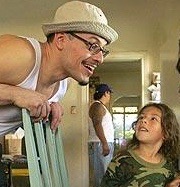 (Photo by Mel Melcon/Los Angeles Times) Sixteen-year-old Mario Rocha was one of nearly 50 people who attended a pay-to-enter party in the backyard of a home in Highland Park, California, on the night of February 16, 1996. An argument among some street gang members erupted into a fistfight and then escalated into a shooting.
Martin Aceves, 17, was struck in the chest and killed. Anthony Moscato, 20, was wounded in the hand as he tried to flee.
On February 23, Rocha and his brother, Danny, neither of whom had any ties to street gangs, were arrested. Danny was released, but Rocha was charged with murder. Also charged with murder were two other party-goers, Raymond Rivera and Anthony Guzman, both in their 20’s.
In December, 1998, Rocha, charged as an adult, went on trial in Los Angeles County Circuit Court along with Rivera and Guzman.
Three prosecution witnesses identified Rocha as the shooter. Two of them testified that he was the person who shot down the driveway toward the street. One of the witnesses identified Rocha with great certainty and the other two identified him with varying degrees of uncertainty. Further, Rocha fit the physical descriptions given by three others at the party.
A jury convicted all three defendants. Rocha was sentenced to 29 years to life for the attempted murder of Moscato and 35 years to life for the murder of Aceves.
While in juvenile detention prior to trial, Rocha met Sister Janet Harris, a Catholic nun, when he was selected for a writing class she taught there. She was struck by his demeanor and was impressed as his writing skills blossomed. Ultimately, she became convinced of his innocence and, after studying the trial transcript, she began her own investigation.
Sister Janet found new witnesses that Rocha’s trial lawyer had either ignored or failed to discover and eventually put together a lengthy summary of the case. In 1998, she persuaded the law firm of Latham & Watkins to take on the case for free.
On December 28, 2005, a California appellate court set aside Rocha’s conviction because of seriously inadequate legal defense provided by his trial attorney.
Evidence presented at a habeas corpus hearing showed that Rocha’s attorney, Anthony Garcia, had failed to call witnesses who could have given exculpatory evidence, that Garcia failed to adequately cross-examine the eyewitnesses and failed to protect Rocha from prosecution attempts to portray him as a gang member.
The appellate court said that Garcia “ignored (Rocha’s) case for a prolonged period after his appointment as counsel, made only desultory efforts, if any, to locate most witnesses and spent very little documented time in preparation of the case. This is such an extreme defalcation of the duty to conduct a timely and reasonable factual investigation of the case as to constitute a breakdown in the adversarial process.”
While still pending, Rocha’s case had garnered considerable public attention due to the involvement of Sister Janet and a documentary film, “Mario’s Story,” was made. After the appellate decision, the state said it would retry him and Rocha’s bond was set at $1 million.
About dozen people, including lawyers and entertainment industry executives helped raise funds and on August 24, 2006, Rocha was released from custody.
On October 28, 2008, the Los Angeles District Attorney dismissed the charges. Rocha sought compensation from the State of California and in December 2013, he was awarded $305,900.
– Maurice Possley |